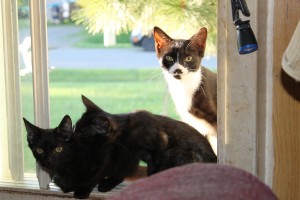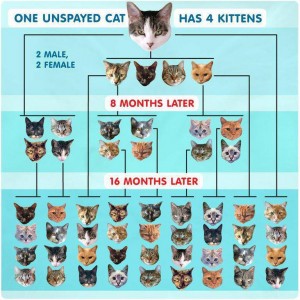Trailer Park Cats
Stephanie Kelley
The Trailer Park in Perth-Andover is now home to a number of stray and homeless cats. This cat colony, which some people estimate to consist of 30 to 50 cats, has now reached critical mass and council finally addressed the issue at their last meeting.

The cat issue was a hot topic on Facebook before the meeting. There was a rumour that there was a plan in the works to simply trap all the strays and “euthanize” them.
Some people were all for this plan of death and destruction, others more moderate, but it was very clear that this is a problem that must be addressed now, before more cats are born.
Bill and Libby Mosher, animal advocates and Victoria County SPCA board members, attended the council meeting to offer their insights and suggestions.
Feral cat colonies are a problem everywhere, but the cats are not to blame…. We humans are. Most of these cats in the trailer park were abandoned by people who left them behind when they moved on. These people likely got new cats when they got to their new home, because hey, they’re just cats, right? Interchangeable and disposable.
The abandoned cats were not spayed or neutered, and so the females went on to produce about two litters per year. Kittens need to be socialized with humans from the time they are very small, or they will grow up to be feral and will never trust humans.
 The kittens had kittens, and so on, until now there’s a problem and people are hollering for a solution.
The kittens had kittens, and so on, until now there’s a problem and people are hollering for a solution.
Bill gave a very thoughtful and impassioned plea to council for the village, and the rest of us, to do the right and compassionate thing, and that is to take responsibility for these animals.
He said, “We humans are real good at killing. We’ve proven that time and time again. We need to eliminate euthanasia as a means of controlling animal populations.”
“Euthanasia is something we do to relieve suffering. When we destroy unwanted animals, let’s call it what it is…. killing. We now have an opportunity to make a positive difference in our community and a chance to educate the public.”
Bill went on to explain that over-population of cats is the biggest challenge that our shelters and rescue groups face today.
Many communities have begun effective programs to trap-neuter and then release (TNR) feral and stray cats back to their territory.
Cats are very attached to their neighbourhoods, and they will not go away if you stop feeding them. Eradication has also never been an effective way to control any animal population. When cats are removed from a location, new animals move in to take advantage of the food source. This is called “the vacuum effect.”
Various posts on Facebook indicated that some people think that simply killing these cats will solve the problem and everyone will be able to go on with their lives. But, before long, new cats will be abandoned or will move in and another colony will develop.
When a community takes control of a situation and begins a TNR program, the cats are taken to the vet where they are spayed or neutered and then have an ear tipped to mark them so they are easily identified as non-breeders.
Studies have proven that trap-neuter-release is the single most successful method of stabilizing and maintaining healthy feral cat colonies with the least possible cost to local governments and residents, while providing the best life for the animals themselves. Spaying/neutering homeless cats:
- Stabilizes the population at manageable levels.Eliminates annoying behaviours associated with mating. Once they are spayed or neutered, most of the fighting, howling and spraying will stop.
- Is humane to the animals and fosters compassion in the neighbourhoods.
- Is more effective and less costly than repeated attempts at extermination: costs for repeatedly trapping and killing feral colonies are far higher than promoting stable, non-breeding colonies in the same location. Vacated areas are soon filled by other cats, who start the breeding process over again.
- We are all community members of this village, and for these cats home is within the community rather than in individual households. These cats, in essence, belong to all of us.
I also read several comments that suggested that these cats would be “better off” if they were destroyed. You cannot apply your own perception of what makes life worth living to these cats. By the same token, we might look at starving people in third world slums and make the same judgement call. I am pretty sure, however, that if asked, those people would choose life over , ahem, euthanasia to remove them from the apparent misery of their lives!
And really, is this the message we want to give to our kids…. If something is annoying you, just kill it?
I visited the trailer park one late afternoon last week. I figured that would be about the time that the cats would begin to move about. Judging from what I had heard, I expected to be confronted by the vision of dozens of cats roaming the streets.
In fact, after circling slowly through the neighbourhood with my camera and notebook for half an hour, I had seen just one cat. Just as I was thinking I’d have to come back later to find any cats, I turned a corner and saw a group of about 10 cats all clustered under a tree next to a trailer.
There was a ramp leading up to an open window, and some of the cats were playing on the sill. I had just found Ellsworth DeMerchant’s informal cat charity operation.
Ellsworth told me he feeds about a dozen of these strays, and they come in and out as they please. As I sat there, a number of them came in and helped themselves to the big bowl of chow sitting on the floor.
Ellsworth said, “I can’t stand to see anyone, animal or human, go hungry!”
They were a little suspicious of me, but I did get to hold and pet one skinny little fellow. These cats are technically homeless, but because of Ellsworth’s compassion and care they are socialized.
These cats can easily be caught and put into carriers while in Ellsworth’s home to be taken to the vet, and they would be good candidates for adoption.
We’ve lost a lot in this village, and the destruction continues as more historic homes are being dismantled and crushed even as I write these words.
Let’s do something for our village that fosters life and compassion instead of death and destruction!
Beginning a TNR program for our community’s stray cats is the right and honourable way to take responsibility for these community members.
Abandoning pets, or leaving them behind when moving is against the law and is an indictable offence. Landlords who find pets that have been left behind usually just call the shelters for help, or simply toss them out. If you know of someone who has abandoned pets call the SPCA Hotline to report them.
It’s sad, but perhaps the threat of legal action will persuade people to do the right thing for their pets and get them spayed or neutered and keep them with them instead of driving off into the sunset, where they will acquire yet more animals.
It’s another sad but true human tendency to assign more value to that in which we have invested money. Spayed and neutered pets represent a financial investment, and so are perceived as more valuable and are more likely to be kept.
It’s estimated that it will take about $4,000 to get the trailer park cats the veterinary care they need. There are other smaller cat colonies in the village as well.
We are very good at pulling together for worthy fund raisers for our village, and this is certainly a worthy cause.
Firemen are traditionally associated with cat rescue operations, from getting cats out of trees to pulling them from burning homes and resuscitating them. They even have special oxygen masks made especially for cats and dogs.
Perhaps our fire department could spearhead a drive to help raise funds or to bring greater public awareness to the cat colony issue.
And, communities that successfully and compassionately deal with cat colonies receive favourable press coverage and public admiration for doing something positive and life affirming for stray cats. Let our village be a model and inspiration for doing the right thing for our community cats!
To donate to the cause or learn more: Perth-Andover Community Cat Rescue
To contact the SPCA Hotline to report cases of animal abandonment, abuse or neglect please call
1-877-722-1522
